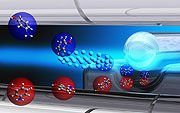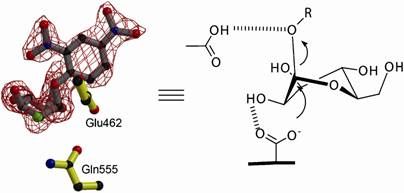Chemistry with sorted molecules
Advertisement
To gain complete control over chemical reactions is one of the main goals of chemists around the world. For the first time, scientists at the University of Basel and the Center of Free-Electron Laser Science in Hamburg were able to successfully sort out single forms of molecules with electric fields and have them react specifically. Analysis of the reaction rates showed a relation between the spatial structure of the sorted molecules and their chemical reactivity.

3-aminophenol conformers in a molecular beam are spatially separated in an electric field and react with calcium ions that have been localized in space by laser cooling.
Universität Basel
The reactivity of a chemical compound, that is the rate at which a substance undergoes a chemical reaction, is strongly influenced by the shape of its molecules. Complex molecules often exhibit different shapes, so-called conformers, in which parts of the molecules vary in their spatial arrangement. However, conformers often interconvert between each other under ambient conditions, so that a detailed study of their individual reactivities has been difficult so far.
Scientists around Prof. Stefan Willitsch from the Department of Chemistry at the University of Basel and Prof. Jochen Küpper from the Center for Free-Electron Laser Science in Hamburg (CFEL, DESY) have developed a new experimental setup that allows to study the reactivity of single isolated conformers. The scientists produced a beam of molecules from which they were able to pick specific conformers with a «molecular sorting machine» in order to specifically inject them into a chemical reaction.
The scientists made use of the fact that a change in the shape of a molecule usually also leads to the modification of its dipole moment. The dipole moment describes how a molecule reacts to an external electric field. Inside this sorting machine, a non-uniform electric field deflects single conformers to varying extents so that they are spatially separated.
In a first experiment, the scientists separated two conformers 3-aminophenol, a well-known compound that is widely used in industry. The two conformers only differ in the position of a single hydrogen atom. The separated conformers were then directed into a reaction chamber where they reacted with electrically charged calcium atoms, so-called ions, in a trap. The ions were cooled down with laser light to almost the absolute zero point of temperature scale at minus 273 degrees Celsius. In this way the ions were localized in space and formed an ideal target for reactions with the spatially separated conformers. Thus, the scientists were able to show that one of the conformers reacted twice as fast with the calcium ions than the other, a phenomenon that could be explained by the different electrical properties of the conformers.
The new method allows insight into fundamental reaction mechanisms and the relations between molecular conformation and chemical reactivity, with potentially far-reaching applications in chemical catalysis and the synthesis of new molecules.
Original publication
Other news from the department science
Most read news
More news from our other portals
See the theme worlds for related content
Topic world Synthesis
Chemical synthesis is at the heart of modern chemistry and enables the targeted production of molecules with specific properties. By combining starting materials in defined reaction conditions, chemists can create a wide range of compounds, from simple molecules to complex active ingredients.

Topic world Synthesis
Chemical synthesis is at the heart of modern chemistry and enables the targeted production of molecules with specific properties. By combining starting materials in defined reaction conditions, chemists can create a wide range of compounds, from simple molecules to complex active ingredients.





























































